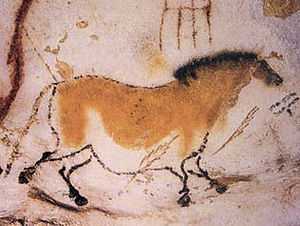Pseudorealism
 |
| History of art |
| Art history |
Pseudorealism, also spelled pseudo-realism, is a term used in a variety of discourses, connoting any artistic and dramatic technique, or work of art, film and literature based on non-realistic ideas but intended to be received by the viewer as based on reality .[1]
The term Pseudorealism has a parallel in mathematical field of representation theory where, a (pseudo real) or Quaternionic representation is a group representation that is equivalent to its complex conjugates.[2][2] This idea that something unreal can still give the impression of the real has caused the adoption of Pseudorealism as a new genre of art.
Much though Pseudorealistic ideas were found in artworks since ages, as a distinct genre of art, it has come to be popularised only in the early 1990s by Indian artist Devajyoti Ray.However since its inception, the style attracted international attention and has been referred by many as the most original of art styles that have come out of India in the present century [1]
Criticism
Much though Devajyoti Ray had initiated the term with a positive connotation as a style of artistic representation, it was often been used rather negatively by critics to describe a variety of film productions, TV programmes, and video games in recent years.[3] where special effects, computer generated imagery and 3D animation are used to augment reality based images. In this context the word pseudoreal has a negative connotation. At the opposite end of the spectrum, the term is also used to describe photorealistic CGI animation and 3D computer graphics indistinguishable from cine-photography.[3]
Some sources also equate pseudorealism with Magic realism, popular in film, literature, and visual arts,[4] or even the cynical pseudo-realism of the Stalinist era as exposed by Orwell.[5] though there are some fundamental differences between magic realism and Pseudorealism. While both create scenes which are based on the unreal, there is an element of fantasy in magic real scenes. Magic real scenes are scenes which a creator desires. In Pseudorealism, the creator is only trying to create a scene that has the appeal of real even though in actuality it is unreal.
Notes and references
- ↑ 1.0 1.1 Eric Loren Smoodin, Ann Martin, Hollywood quarterly: film culture in postwar America, 1945-1957. Page 235. University of California Press.
- ↑ 2.0 2.1 David Surman | Swinburne University of Technology - Academia.edu. Swinburne.academia.edu. Retrieved on 2010-10-21.
- ↑ 3.0 3.1 David Surman, Master's Thesis: CGI Animation - Pseudorealism, Perception and Possible Worlds. GameCareerGuide.com. Retrieved on 2010-10-21.
- ↑ What is pseudo-realism? Pseudo-realism.com.
- ↑ Christopher Hitchens, Why Orwell Matters. Page 93. Basic Books, 2003. ISBN 0465030505.
| Wikiquote has quotations related to: Pseudorealism |
- http://onedimensional.wordpress.com/2006/11/10/vivaah-movie-review/
- http://www.gamecareerguide.com/education/theses/20040928/DavidSurmanThesis.pdf
- http://www.thefreelibrary.com/Pseudorealism-a01073935617
- http://www.allwords.com/word-pseudorealism.html
- http://artofbengal.com/ideas.htm
- http://www.buzzintown.com/ahmedabad/article-review_exploring-reality-pseudo-realism--id_1227.html